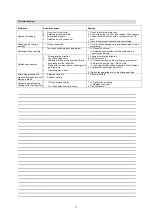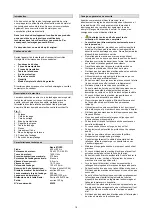
Disposal
Disposal instructions are illustrated in the form of
pictograms on the device or packaging. Description of the
pictograms is given in "Identification" chapter.
Disposal of transport packaging
Packaging protects the device against damage during
transport. Packaging materials are usually selected
according to their effect on environment and disposal
methods and can therefore be recycled.
Returning of the packaging back to circulation saves
resources and costs for packaging disposal.
Parts of the packaging (e.g. foil, styropor) may be
dangerous for children.
Risk of suffocation!
Keep these parts of the packaging out of reach of children
and dispose as soon as possible.
Operator requirements
The operator must carefully read the Operating
Instructions before using the appliance.
Qualification
No special qualification is necessary to use the appliance
apart from detailed instructions by an expert.
Minimum age
The appliance may only be operated by persons over 18
years of age who have been instructed in handling and
operating the appliance. Young people between 16 and 18
years of age may only work with the appliance when
supervised by an adult.
An exception includes youngsters operating the appliance
within their professional education to achieve necessary
skills under trainer's supervision.
Training
Using the appliance only requires appropriate instructions
by an expert or reading the Operating Instructions. No
special training necessary.
Inspections and servicing (pic. 1+2+10)
Safety instructions for inspections and servicing:
Only a regularly serviced and treated appliance may be a
satisfactory aid. Inadequate servicing and maintenance
may lead to unforeseen accidents and injuries.
•
Never use aggressive cleaning agents to clean
the appliance. That could damage or destroy the
appliance.
•
Unplug the appliance.
•
Have any repairs and servicing of the electrical
equipment provided by electricians only.
•
All protective and safety equipment must be
immediately refitted after repairs and servicing works
are finished.
The following is recommended (pic. 2):
•
Splitting knife
The splitting knife is a component that is subject to
quick wear and must be ground down additionally if
necessary. That will increase the splitting output and
protect the splitter.
Tip: lubricate the splitting knife
with fat!
•
Two-hand protective equipment
The combined holding and clamping equipment must
run easily. From time to time, lubricate it with a few
drops of oil.
•
Splitting post
Every time the appliance is to be used, lubricate the
splitting post with fat. That will increase the service
life of the sliding jaws (pic. A./2). Pull the splitting post
out to the full extent and equally apply multi-purpose
fat to all 4 sides of the splitting post.
•
Movable parts
Keep the splitting knife guide clean (remove any dirt,
splinters, bark, etc.). Slide rails to be lubricated with
fat.
•
Hydraulic equipment
Hydraulic connections screwing should be checked
for leaking and wear. Tighten the screwing if
necessary.
Checking the hydraulic oil level (pic. 1+10):
Check the hydraulic oil level only when in a cold
condition, feeder cable disconnected and splitting
post pulled in.
On the oil level dipstick there are two notches – the lower
(pic. 10/1) is the minimum hydraulic oil limit level in the
tank and the upper notch (pic. 10/2) is the maximum limit.
•
Unscrew the oil level dipstick (pic. 1/11) from the
opening.
•
Wipe the oil from the dipstick with a non-felt cloth.
•
Re-screw the dipstick in the opening.
•
Unscrew the filling screw with the dipstick again
and check whether the hydraulic oil upper limit is
between both notches.
Change the oil once a year (pic. 1+10):
•
Unscrew the oil drain plug (pic. 1/11).
•
Catch the waste oil (every model with different
amount)
•
Dispose the waste oil in an environment-friendly
manner
•
Re-screw the oil drain plug.
No particles of dirt may
get in the oil tank.
•
Add the hydraulic oil up to the upper notch on the
dipstick (pic. 10/2)
•
Try the wood splitter with no load several times.
Recommended hydraulic oil: DIN ISO HLP 46
Güde Art. No.
42004
Viscosity: 46
Oil amount:
(see Technical specifications)
Oil to be added only when the splitting post is in
the engaged position.
Hydraulic equipment:
Hydraulic hoses and couplings must be checked after app.
4 hours of operation whether tight and must be tightened if
necessary.
Checking the appliance whether it is working properly
The hydraulic wood splitter is supplied in a ready-to-
operate state. The following functional checks need to be
carried out every time the appliance is to be used.
•
Let both switching handles go down and the splitting
knife as low as app. 5 cm above the table
•
Lower one switching handle at a time – the splitting
knife will remain in the selected position
Optional supply
Basic 8T/D-8T/DTS splitting cross
Art. No. 02027
Basic 8T/D-8T/DTS splitting wedge extension
Art. No. 02033
Basic 8T/DTS splitting wedge extension
Art. No. 02032
16
Содержание 02030
Страница 2: ...2 A 3 1 4 5 2 8 9 1 6 10 3 7 11 2...
Страница 3: ...4 6 5 8 9 1 2 10 3...














































